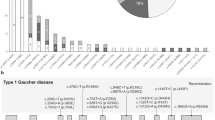Abstract
The only prognostic markers in Gaucher disease, the most common lysosomal storage disorder, are young age at first symptom/sign and the presence of null/severe mutations, both being predictive of more severe phenotypes. Therefore, it would be helpful to know whether siblings with the same genotype can be expected to experience comparable phenotypic expression. All non-neuronopathic sibling pairs in our referral clinic (1993–2008) with the same genotype were included. For each pair, gender, date of birth, severity score index at presentation, age at diagnosis and first symptom/sign, presence of bone involvement, spleen status, and use of enzyme replacement therapy were tabulated. There were 90 pairs of siblings: two sets of identical twins; 24 pairs of brothers, 24 pairs of sisters, and 42 pairs of mixed gender. For all measures of disease severity used, only in sibling pairs with an older sister and a younger brother were phenotypes significantly different between siblings. Thus, this large cohort of sibling pairs with type 1 Gaucher disease confirmed that, in general, the phenotypic expression in the younger sibling will be similar enough to that of an older affected sibling that genetic counseling may use those findings in a prognostic way.
Similar content being viewed by others
Abbreviations
- SSI:
-
severity score index
- ERT:
-
enzyme replacement therapy
References
Amato D, Stachiw T, Clarke JT, Rivard GE (2004) Gaucher disease: variability in phenotype among siblings. J Inherit Metab Dis 27:659–669
Barton NW, Brady RO, Dambrosia JM et al (1991) Replacement therapy for inherited enzyme deficiency: macrophage-targeted glucocerebrosidase for Gaucher’s disease. N Engl J Med 324:1464–1470
Beutler E, Grabowski GA (2001) Gaucher disease. In: Scriver CR, Valle D, Beudet A et al (eds) The metabolic and molecular bases of inherited disease. McGraw-Hill, New York, pp 3635–3668
Elstein D, Abrahamov A, Hadas-Halpern I, Meyer A, Zimran A (1998) Low-dose low-frequency imiglucerase as a starting regimen of enzyme replacement therapy for patients with type I Gaucher disease. Q J Med 91:483–488
Lachmann RH, Grant IR, Halsall D, Cox TM (2004) Twin pairs showing discordance of phenotype in adult Gaucher’s disease. Q J Med 97:199–204
Levy-Lahad E, Zimran A (1997) Gaucher’s disease: genetic counselling and population screening. Baillieres Clin Haematol 10:779–792
Ramsay SL, Maire I, Bindloss C et al (2004) Determination of oligosaccharides and glycolipids in amniotic fluid by electrospray ionisation tandem mass spectrometry: in utero indicators of lysosomal storage diseases. Mol Genet Metab 83:231–238
Whitfield PD, Nelson P, Sharp PC et al (2002) Correlation among genotype, phenotype, and biochemical markers in Gaucher disease: implications for the prediction of disease severity. Mol Genet Metab 75:46–55
Zimran A, Sorge J, Gross E, Kubitz M, West C, Beutler E (1989) Prediction of severity of Gaucher’s disease by identification of mutations at DNA level. Lancet 2:349–352
Zimran A, Elstein D, Kannai R et al (1994) Low-dose enzyme replacement therapy for Gaucher’s disease: effects of age, sex, genotype, and clinical features on response to treatment. Am J Med 97:3–13
Zimran A, Abrahamov A, Elstein D (2000) Children with type I Gaucher disease: growing into adulthood with and without enzyme therapy. Isr Med Assoc J 2:182–183
Zimran A, Morris E, Mengel E et al (2009) The female Gaucher patient: the impact of enzyme replacement therapy around key reproductive events (menstruation, pregnancy and menopause). Blood Cells Mol Dis 43:264–288
Acknowledgements
The authors would like to acknowledge the considerable expertise and patience of Ms. Tali Bdolah-Abram of the Hebrew University who performed all the statistical analyses and who thereby enabled us to have a more cogent understanding of the data.
Author information
Authors and Affiliations
Corresponding author
Additional information
Communicated by: Ed Wraith
Conflict of interests: None of the authors had any conflicts of interest that might have affected this study or the results herein reported. No funding was received for this project.
Rights and permissions
About this article
Cite this article
Elstein, D., Gellman, A., Altarescu, G. et al. Disease severity in sibling pairs with type 1 Gaucher disease. J Inherit Metab Dis 33, 79–83 (2010). https://doi.org/10.1007/s10545-009-9024-7
Received:
Revised:
Accepted:
Published:
Issue Date:
DOI: https://doi.org/10.1007/s10545-009-9024-7




